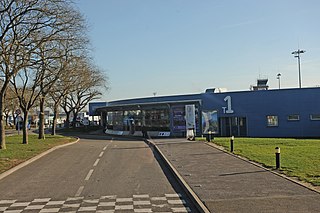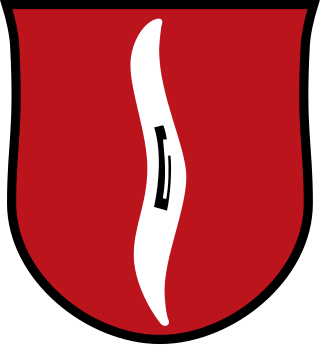
Beauvais–Tillé Airport, branded as Paris-Beauvais Airport, is an international airport near the city of Beauvais in the commune of Tillé in France. In 2016, it was the tenth busiest airport in France, handling 3,997,856 passengers, and is mostly used by charter and low-cost airlines.

Between 1933 and 1945, the organization of the Luftwaffe underwent several changes. Originally, the German military high command, for their air warfare forces, decided to use an organizational structure similar to the army and navy, treating the aviation branch as a strategic weapon of war. Later on, during the period of rapid rearmament, the Luftwaffe was organized more in a geographical fashion.

Rennes–Saint-Jacques Airport or Aéroport de Rennes–Saint-Jacques is a minor international airport about 6 kilometres (3.7 mi) southwest of Rennes, Ille-et-Vilaine, in the region of Brittany, France.
Luftflotte 4 was one of the primary divisions of the German Luftwaffe in World War II. It was formed on March 18, 1939, from Luftwaffenkommando Österreich in Vienna. The Luftflotte was redesignated on 21 April 1945, to Luftwaffenkommando 4, and became subordinated to Luftflotte 6. It was the Luftflotte 4, that was responsible for the bombing campaign of Stalingrad, where ca. 40,000 civilians died. This Luftwaffe detachment was based in Romania, Bulgaria, Southeast Poland, Hungary, Ukraine and Russian occupied territories, for supporting Axis forces; with command offices in Morczyn, Hungary, during 26 June 1944, Eastern Front.
Luftflotte 3 was one of the primary divisions of the German Luftwaffe in World War II. It was formed on 1 February 1939 from Luftwaffengruppenkommando 3 in Munich and redesignated Luftwaffenkommando West on 26 September 1944. This Luftwaffe detachment was based in German-occupied areas of Northern France, the Netherlands, Belgium, and Vichy France, to support the Axis power's forces in area. Its command offices were in Paris, France.
Luftflotte 6 was one of the primary divisions of the German Luftwaffe in World War II. It was formed on May 5, 1943 from Luftwaffenkommando Ost in Central Russia (Smolensk). The Luftwaffe units listed here were detached in Belarus, East Poland, East Prussia, Ukraine, Slovakia and in Russian-occupied lands for air support of Axis forces in the sector; with command offices in Pryluky and Belarus during June 26, 1944 within the Eastern front.

Kampfgeschwader 4 "General Wever" was a Luftwaffe bomber wing during World War II. The unit was formed in May 1939. The unit operated the Dornier Do 17, Junkers Ju 88 and Heinkel He 111 medium bombers, with later service on the Heinkel He 177 heavy bomber. The wing was named after General Walther Wever, the prime pre-war proponent for a strategic bombing capability for the Luftwaffe, who was killed in an aircraft accident in 1936.

Kampfgeschwader 3 "Blitz" was a Luftwaffe bomber wing during World War II.
Kampfgeschwader 51 "Edelweiss" (KG 51) was a Luftwaffe bomber wing during World War II.

Kampfgeschwader 76 was a Luftwaffe bomber Group during World War II. It was one of the few bomber groups that operated throughout the war.
Kampfgeschwader 77 was a Luftwaffe bomber wing during World War II. Its units participated on all of the major fronts in the European Theatre until its dissolution in 1944. It operated all three of the major German bomber types; the Dornier Do 17, Heinkel He 111 and the Junkers Ju 88.

Unternehmen Paula is the German codename given for the Second World War Luftwaffe offensive operation to destroy the remaining units of the Armée de l'Air (ALA), or French Air Force during the Battle of France in 1940. On 10 May the German armed forces (Wehrmacht) began their invasion of Western Europe. By 3 June, the British Army had withdrawn from Dunkirk and the continent in Operation Dynamo, the Netherlands and Belgium had surrendered and most of the formations of the French Army were disbanded or destroyed. To complete the defeat of France, the Germans undertook a second phase operation, Fall Rot, to conquer the remaining regions. In order to do this, air supremacy was required. The Luftwaffe was ordered to destroy the French Air Forces, while still providing support to the German Army.

X. Fliegerkorps was a formation of the German Luftwaffe in World War II, which specialised in coastal operations. It was formed 2 October 1939, in Hamburg from the 10. Flieger-Division.

Kampfgeschwader 26 "Löwengeschwader" was a German air force Luftwaffe bomber wing unit during World War II. Its units participated on all of the fronts in the European Theatre until the end of the war. It operated three of the major German aircraft medium bomber types; the Heinkel He 111, Junkers Ju 88 and the Junkers Ju 188. The unit engaged in both strategic bombing, close air support, anti-shipping and aerial interdiction operations. The majority of its operational life – not entirely unlike another Luftwaffe wing designated KG 40 — was spent on anti-shipping missions.
Châteaudun Air Base was a French Air Force (French: Armée de l'Air base, between 1934 and 2014. The base was located approximately 3.5 kilometres southeast of Châteaudun and about 112 kilometres southwest of Paris. It is currently an airfield attached to Orléans – Bricy Air Base.

Brétigny-sur-Orge Air Base is a former French Air Force French: Armée de l'Air (ALA) base. The base is located approximately 2 miles (3.2 km) southeast of Brétigny-sur-Orge; about 17 miles (27 km) south of Paris.

Pontoise Aerodrome or Pontoise – Cormeilles Aerodrome is an airport located 7 km (3.8 NM) northwest of Pontoise in Boissy l'Aillerie near Cormeilles-en-Vexin, all communes of the Val-d'Oise department in the Île-de-France region in northern France. The airport is also located 16 miles (26 km) northwest of Paris.

Kampfgeschwader 1 was a German medium bomber wing that operated in the Luftwaffe during World War II.
Max Bucholz was a German Luftwaffe ace and recipient of the Knight's Cross of the Iron Cross during World War II. Bucholz was credited with between 28 and 30 victories, including an ace in a day.
Zerstörergeschwader 2 was a Luftwaffe heavy/destroyer Fighter Aircraft-wing of World War II.













